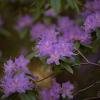January 14, 2010 - 8:29am
Five-year-old Alden Thom is one of Vancouver Island University’s youngest donors.
Alden was so impressed by his recent visit to the sturgeon tanks at VIU, he decided to raise money at his 5th birthday party to help the endangered species.
“Instead of presents for himself, Alden decided to collect twoonies from the kids at the party so he could do something important,” said his mom Karen. “Alden’s immediate idea was to help the sturgeon at VIU.”
On Thursday, Alden donated $35 to VIU President Dr. Ralph Nilson and Dr. Harald Rosenthal, President of the World Sturgeon Conservation Society. Rosenthal happened to be on campus to review plans for VIU’s $4.8-million International Centre for Sturgeon Studies (ICSS), currently under construction.
Alden decided to raise money for the sturgeon project after attending a public lecture and tour of the sturgeon tanks with his mom and seven-year-old brother last November. Alden, who attends kindergarten in Ladysmith, is a “big nature enthusiast and loves fish,” said Karen. “He’s naturally inquisitive. His favourite activities include mushroom hunting, looking for salamanders with his friends and exploring forests. He spends hours poring over books, especially stories about fish and other marine life.”
Alden loves Tale of the Great White Fish, a book by Maggie de Vries and frequently asks how the sturgeon are doing in the Fraser River. When his mom heard about the VIU lecture and public tour, it was an educational opportunity her family couldn’t miss.
VIU Fisheries and Aquaculture technicians Dave Switzer and Gord Edmondson showed Alden and others the sturgeon and other marine life. “Alden was thrilled,” said Karen, “especially when he got to touch a sturgeon. He really wants to see the sturgeon moved into bigger tanks.”
Alden will soon get his wish. The ICSS at the Nanaimo campus is expected to be completed by summer.
The Centre will be fully operational for an international conference of the North American Chapter of the World Sturgeon Conservation Society in July 2011. VIU and the City of Nanaimo also won the bid to host the 7th International Symposium on Sturgeon in 2013. The five-day symposium is expected to draw hundreds of educators, researchers, environmentalists, and sturgeon enthusiasts from around the world. The international symposium, which occurs once every four years, will be held at the ICSS and the Vancouver Island Conference Centre in downtown Nanaimo.
Julie Keenan, Development Manager for the Development and Alumni Office, said 70 per cent of the $4.8-million needed to build the ICSS has been raised, including $1.6-million each from the B.C. Knowledge Development Fund (BCKDF) and the Canada Foundation for Innovation (CFI).
Alden’s $35 donation may be small but it is still significant, said Edmondson. “We greatly appreciate Alden’s efforts to help the sturgeon.”
-30-
ABOUT the ICSS:
Researchers will use the ICSS to address the conservation and protection of sturgeon species worldwide, and investigate the viability of environmentally responsible sturgeon aquaculture through land-based, closed containment facilities in BC and across Canada.
The ICSS will include state-of-the-art fish holding facilities, fresh water recirculation technology, three wet laboratories, a dry lab for sample processing and analysis, and lab equipment for specialized research in environmental physiology, forensic, nutrition, health, reproduction and genetic research. VIU President Dr. Ralph Nilson said the ICSS “will provide valuable training opportunities for faculty and students, significantly expand our knowledge about sturgeon at regional, provincial, national and international levels, and serve as a magnet for sturgeon scientists from around the world.”
For more information about the ICSS, contact Julie Keenan at 250-740-6602 or visit www.viu.ca/sturgeon.
BACKGROUNDER ABOUT Sturgeon:
VIU, a leader in sturgeon research in BC for over 20 years, is the only academic institution in western Canada to have captive white sturgeon broodstock - fish old enough to spawn. In 1991, researchers successfully conducted the first captive spawning of Fraser River white sturgeon. For several years, VIU has provided fertilized eggs and fry for the start-up of BC’s only commercial white sturgeon culture operation in Sechelt, BC.
Sturgeon eggs, known as true caviar, are a gourmet delicacy, and sturgeon fillets are widely prized. The caviar industry worldwide generates $500-million in annual sales, making it one of the world’s most valuable wildlife resources.
Overfishing, poaching, pollution and habitat loss have devastated wild sturgeon stocks around the world. Most species are endangered or threatened, and are listed by CITES (the Convention on International Trade of Endangered Species), and in Canada by SARA (the Species At Risk Act).
Almost all of the world’s 28 species or subspecies of sturgeon are endangered, threatened or near extinction. Poaching, pollution, overfishing and loss of habitat threaten their survival.
Sturgeon are prehistoric fish, often called living fossils. They are the largest freshwater fish in the world, and date back to the Jurassic period more than 200 million years ago.
In the United Kingdom, sturgeon are known as the "Royal Fish." According to medieval law, anyone who catches a sturgeon must present it to the Queen.
Sturgeon can live for 150 years, but only live in the northern hemisphere.
Nine species of sturgeon are found in North America, including five in Canada and two on the Pacific Coast - green sturgeon and white sturgeon. In BC, white sturgeon live in the Fraser and Columbia river systems, with the largest populations in the lower Fraser River.
The biggest species in the world is the Beluga sturgeon found in the Caspian Sea. They can grow to 26 feet in length and weigh more than 3,000 pounds.
The white sturgeon, found in North America (including BC) can grow to more than 19 feet and weigh more than 1,700 pounds.
It is widely believed that the very large (1,000 pound-and-over specimens) have been fished out.
In 1897, a white sturgeon was landed in New Westminster, weighing 1,384 pounds, possibly one of the last of the big fish in the Fraser River.
Although they look like sharks, sturgeon are not related to sharks at all.
Sturgeon have five rows of bony plates called "scutes" running down their body, and four "barbells" or whiskers hanging down in front of their mouth.
Sturgeon do not have teeth, and feed mostly on fish, dead or alive.
In BC, white sturgeon provide a catch and release sport fishery worth $15-million annually in the lower Fraser River.
California has developed a $20-million dollar commercial sturgeon farming industry for both meat and caviar, due largely to the efforts of researchers at the University of California, Davis.
Sturgeon farms are considered by ecology and conservation-minded organizations such as the Monterey Bay Aquarium to offer an eco-friendly alternative because the closed containment farming methods do not pollute local water or reduce wild stocks.
Tags: In the Community






